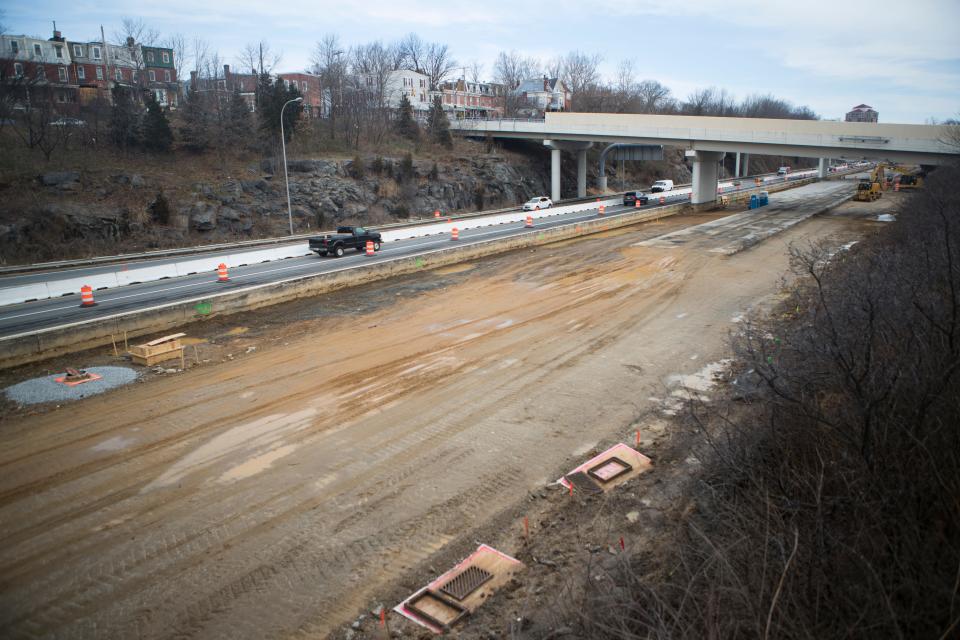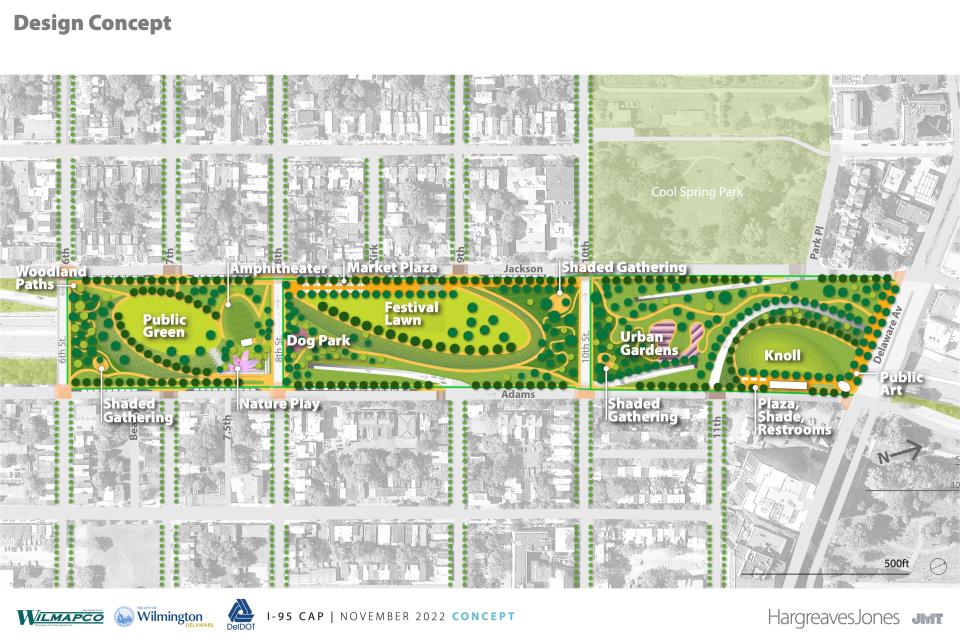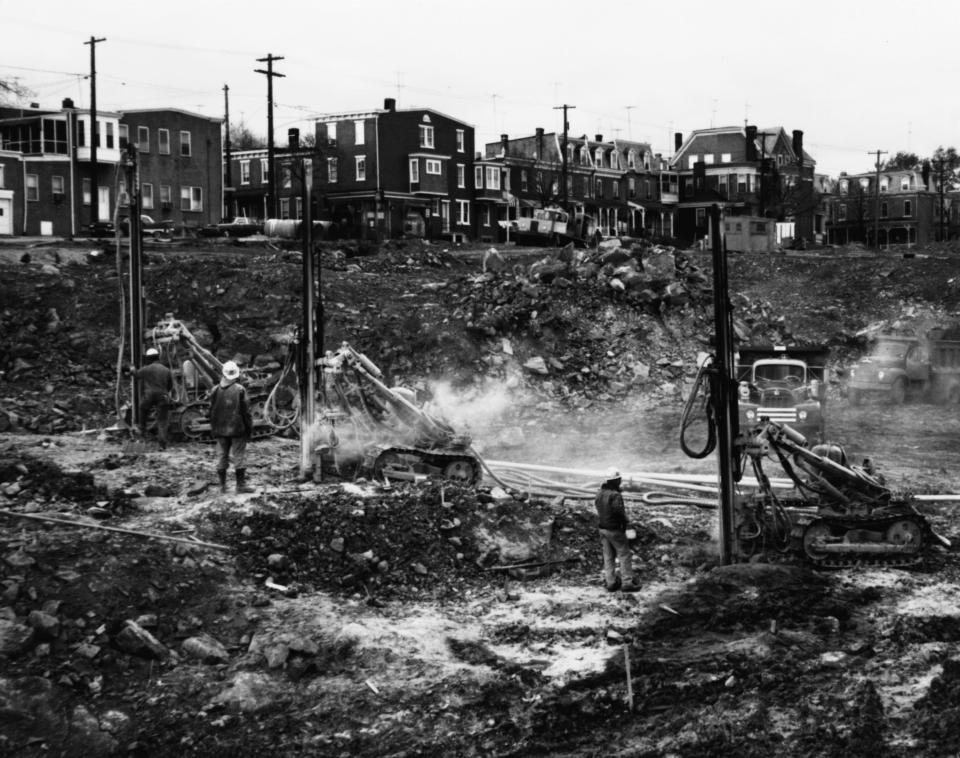Plan to build park on I-95 stalled due to lack of money for almost $400 million project
It's been almost 30 years since the first public proposal to build a park on top of a section of I-95 that runs through the city of Wilmington. Proponents of the idea cited lack of funding as the reason the project never took off. Despite excitement drummed up by elected officials, it appears that more recent efforts have achieved the same result.
Even with political appeals by state and congressional officials to draw federal investment, representatives from the Delaware Department of Transportation and Wilmington said there is still no funding for a much-touted plan to build a roof over the highway with a park on top to reconnect neighborhoods split apart in the 1960s.
The standstill follows a $347,000 feasibility study and more than a year of community stakeholder meetings.
In partnership with DelDOT, the Wilmington Area Planning Council, a regional transportation planning agency for New Castle County and Cecil County, Maryland, commissioned the study to estimate the construction project's costs and traffic impacts after community input was taken into account, according to the study's project manager, Dave Gula.

After 16 months of community stakeholder meetings, the final design concept was presented in November 2022. The cap would cover the stretch of I-95 in Wilmington between Sixth Street and Delaware Avenue bordered by North Jackson Street and North Adams Street. The Seventh Street and Ninth Street overpasses would be permanently shut down. Traffic lanes on North Jackson Street and North Adams Street would be reduced from two to one. Lanes on those streets used for parking would be converted to sidewalks and bike lanes.
Planned park amenities suggested by residents who participated in stakeholder meetings include:
Public green overlooking an amphitheater
Festival lawn
Walking paths and biking areas
Children's play areas
Space for pop-up markets for local vendors
Dog park

Gula suggested that the project would take about 10 years to complete and be less costly at $360 million if the cap was built in one installment, but if the project was broken up, each stage would take five to six years to complete at these estimates:
Sixth Street to Eighth Street: $93 million-$105 million
Eighth Street to 10th Street: $117 million-$132 million
10th Street to Delaware Avenue: $140 million-$158 million
Gula said the effort to build the rooftop park would be a feat of major engineering, involving long-term, coordinated planning from numerous authorities, including the city, state and federal governments. He emphasized that because of the variables, any projected costs in time and money are very preliminary.
Federal grant money sought to pay for cap project
State leaders hope to obtain federal money to fund the almost $400 million project.
In 2021, state legislators from Wilmington — Rep. Sherry Dorsey Walker, Rep. Gerald Brady, Rep. Nnamdi Chukwuocha, Sen. Sarah McBride, Sen. Darius Brown and Sen. Tizzy Lockman — signed a letter to U.S. Transportation Secretary Pete Buttigieg asking for federal assistance to build a national park over that highway to reconnect those communities.
Last week, DelDOT spokesperson C.R. McLeod said they expect the state to apply for a grant from the Reconnecting Communities and Neighborhoods program. McLeod said the next opportunity to apply for the grant will be this summer, but they do not yet have dates of when the application window would be open.
President Joe Biden’s infrastructure bill allocated $1 billion to reconnect communities divided by highways and other roads. Proponents of the I-95 cap in Wilmington are confident this project meets the standards necessary to obtain grant money but acknowledged the federal grant process is extremely competitive. Even if the grant were awarded, it covers only 50% of costs, leaving the state to find a way to pay for the rest.
PEDALING BIKE TRAILS: Your guide to cycling in Delaware. See the best trails, with more in the works.
When asked about the next steps, spokespeople from both DelDOT and the city of Wilmington emphasized that they are still very early in the process of planning this structure and could not offer further details. John Rago, the mayor's deputy chief of staff, said once plans have been more fully developed based on the availability of funding, they will be shared widely with the public.
McLeod said in the meantime, the agency is discussing with the city administration to implement the bike and pedestrian improvements along Adams and Jackson streets that were identified during the study.
A highway that divided a city
The enormous construction project is an ambitious attempt to reconnect city neighborhoods torn apart in the 1960s when homes and businesses were leveled for the new I-95.
At that time, planners had no obligation to consider public opinion, economic impact or environmental factors. Local government officials failed to study other routes or coordinate the highway plans with its urban renewal plans. The highway paved over a two-block-wide swath of 360 to 370 homes on the West Side between Adams and Jackson streets, in addition to two churches.

Wilmington soon saw rapid and significant erosion of its residential and commercial base, as businesses and homeowners fled to the suburbs. The area carved away from the old West Side by I-95 became known as West Center City, where the community of working-class white homeowners rapidly transitioned to one of poor, Black renters.
In the 55 years since the 1968 riots following the assassination of Martin Luther King Jr., and the response from the National Guard that resulted in the longest occupation of an American city since the Civil War, the area has languished economically. The I-95 cap project is one of many ideas meant to rehabilitate and revitalize this once-vibrant neighborhood. City leaders have long held that funding problems were at the heart of just about every failed plan to invest in the West Center City community.
Contact reporter Anitra Johnson at ajohnson@delawareonline.com. Join her on the Facebook group Delaware Voices Uplifted. Support her work and become a subscriber.
This article originally appeared on Delaware News Journal: I-95 cap project in Wilmington: Park plan lacks money

